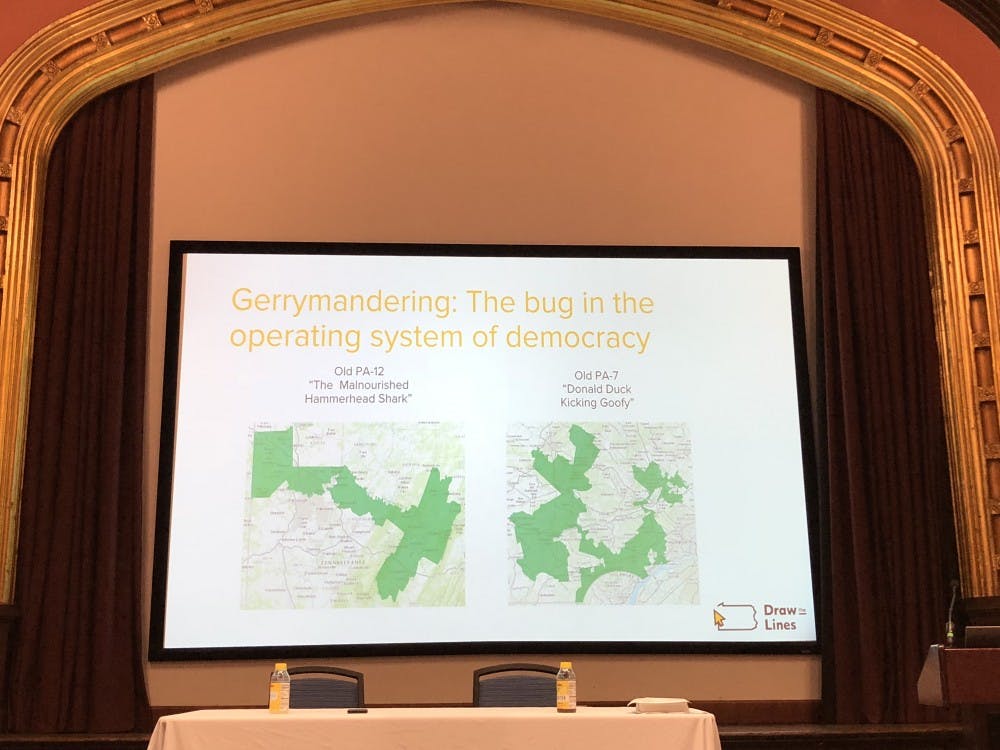
In honor of National Constitution Day, Penn faculty and students gathered in Houston Hall for an interactive presentation on a recent hot-button political issue: gerrymandering.
Penn’s Office of Community Affairs hosted Philadelphia’s Committee of Seventy, a nonpartisan and non-profit organization dedicated to promoting good government in Philadelphia, marking the launch of the Committee's new initiative, "Draw the Lines PA."
The group, in partnership with roughly 60 Pennsylvania universities and colleges, will be taking the initiative across the state over the next three years to raise awareness about gerrymandering leading up to the 2020 elections. The Committee of Seventy considers gerrymandering a top priority, the group's Chief Advancement Officer Lauren Cristella said.
The Committee of Seventy hoped “to make a splash here at Penn to start” by opening a discussion and encouraging the audience to complete interactive gerrymandering worksheets and activities, Cristella said.
The group will visit Temple University, Villanova University, and Drexel University in the coming weeks. In doing so, Cristella said the group hopes “to have people who care about either the issue of gerrymandering or the use of data and mapping software to understand the role that they can have in our government and public policy.”
“You don’t need a PhD in GIS [Geographic Information System] to be able to draw these maps or have them be drawn by the politicians who have different interests,” Cristella said.
Draw the Lines PA aims to educate and democratize Pennsylvania’s redistricting process through recently-developed digital tools, which started in development two years ago and will supposedly be free and accessible to the general public.
The DistrictBuilder software, which was launched today and demonstrated during the presentation, allows users to create a version of their ideal district maps based on their preferred values, including minority representation, district compactness, and opportunity for competitive elections.
“Normally, at the time election maps are drawn, only very expensive, commercial proprietary tools are available. This will be the first time statewide voters will have a roughly equivalent digital tool," said Chris Satullo, Draw the Lines PA program director and co-founder of the Penn Project for Civic Engagement.
Through this software, Draw the Lines PA is organizing a “mapathon” until Dec. 14, in which people can submit their own congressional map of Pennsylvania. Though a $4,500 prize is reserved for the statewide winner, Satullo said they nevertheless want “every member to share their map with their elected official. That sends a message to the politicians.”
The Supreme Court of Pennsylvania ruled earlier this year that Pennsylvania's GOP-drawn congressional map is in violation of the Constitution of the Commonwealth of Pennsylvania. Pennsylvania’s congressional map has been widely cited an “extreme example of gerrymandering,” and has been ranked among the “most skewed maps by multiple measures,” Philly.com reported. Since the original map was drawn in 2011, Republicans have consistently won the same 13 of 18 House seats, despite the fact that votes cast in the state were evenly split between the parties.
"We have a situation now where politicians pick the voters, rather than voters picking the politicians," Satullo said.
Attendees, which included some Penn faculty as well as students in political groups like Penn Leads the Vote, later participated in interactive exercises that focused on practicing gerrymandering strategies that political parties use.
College junior Isabella Fierro, a former intern for the Committee of Seventy, said bringing awareness to gerrymandering is important.
“It’s one of those issues that people don’t talk about as much as compared to healthcare, but it’s actually just as important," she said.
The Daily Pennsylvanian is an independent, student-run newspaper. Please consider making a donation to support the coverage that shapes the University. Your generosity ensures a future of strong journalism at Penn.
Donate




